6.04 The Genetic Code
Overview of the Genetic Code
- Genetic Code: The sequence of DNA bases that encodes the amino acid sequence in proteins.
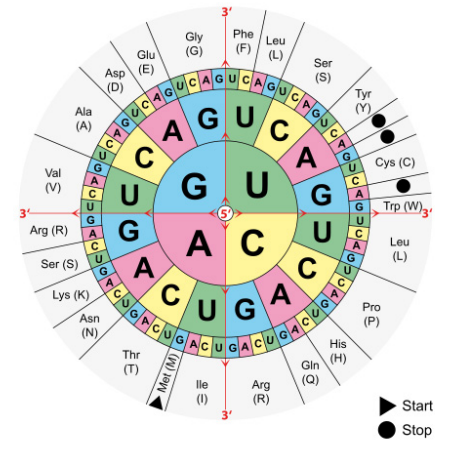
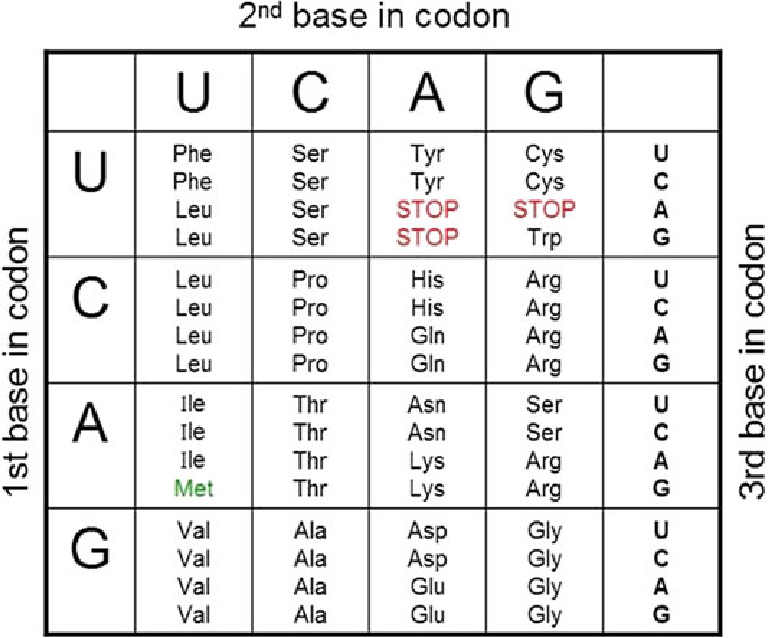
Logic Behind the Genetic Code
- Cell Control via Enzymes:
- Cell functions are controlled by enzymes, which are types of proteins.
- Each protein has a unique sequence of amino acids that determines its shape and function.
- Therefore, the DNA base sequence must code for the sequence of amino acids in proteins, thus controlling cellular activity.
- Gene Definition:
- A gene is a segment of DNA that codes for a specific polypeptide or protein.
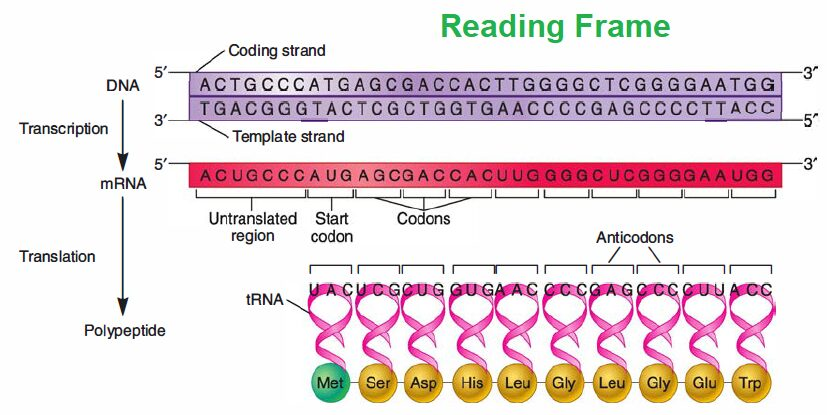
Triplet Code
- Triplet Code Hypothesis:
- Since there are 20 amino acids but only 4 DNA bases (A, T, G, C), a single base cannot code for one amino acid.
- Two-base codes yield only 16 combinations (4 x 4), still insufficient for 20 amino acids.
- Three-base codes provide 64 combinations (4 x 4 x 4), sufficient to code for 20 amino acids with some redundancy.
- Outcome: The genetic code is a triplet code, where each set of three bases (codon) specifies one amino acid.
Features of the Genetic Code
Three-Letter (Triplet) Code:
- Each amino acid is specified by a triplet of bases (e.g., TAC codes for methionine, or “Met”).
Universality:
- The genetic code is universal, meaning it is used the same way across all living organisms.
- Implication: This universality suggests a common evolutionary origin for all life forms.
Punctuation (Start and Stop Codons):
- Certain triplets act as start codons (e.g., TAC for methionine) or stop codons to signal the beginning and end of a protein-coding sequence.
Redundancy (Degeneracy):
- The genetic code is degenerate, meaning some amino acids are encoded by more than one triplet.
- Example: Cysteine can be encoded by ACA or ACG. This reduces the impact of mutations, as a change in the third base might still produce the same amino acid.
Questions and Answers
Can you work out the general formula for predicting how many amino acids can be coded for by four bases?
- Answer: For a code using groups of “n” bases, the formula is 4^n (since there are 4 bases: A, T, G, C).
- Single Base (n = 1): 4 combinations (inadequate for 20 amino acids).
- Two Bases (n = 2): 4^2 = 16 combinations (also inadequate).
- Three Bases (n = 3): 4^3 = 64 combinations (sufficient for coding 20 amino acids with redundancy).
What does the fact that the code is universal suggest?
- Answer: The universality of the genetic code suggests that all life shares a common evolutionary ancestor. This implies that the genetic code originated early in evolutionary history and has been conserved across diverse species due to its fundamental role in protein synthesis.
Chargaff’s Rule in Genetics
Chargaff’s Rule:
In DNA, the proportion of nucleotide bases follows specific pairing rules:
- Adenine (A) pairs with Thymine (T):
Amount of A = Amount of T - Cytosine (C) pairs with Guanine (G):
Amount of C = Amount of G - The total of purines (A + G) equals the total of pyrimidines (T + C):
A + G = T + C
Key Points:
- Chargaff’s rule applies to double-stranded DNA only.
- It ensures base pairing, which is critical for DNA structure and replication.
- Ratios may not apply to single-stranded DNA or RNA, which lack base-pairing.
Ratio Calculation:
- The percentage composition of bases can be calculated if one or two values are known.
Example Problem 1:
- If DNA has 30% Adenine, calculate the percentages of Thymine, Cytosine, and Guanine.
Solution:
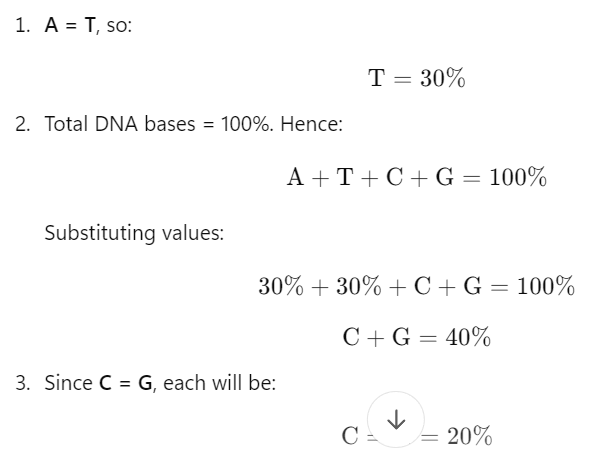
Answer:
- A = 30%, T = 30%, C = 20%, G = 20%.
Example Problem 2:
- A DNA sample has 40% Cytosine. Calculate the percentage of Adenine, Thymine, and Guanine.
Solution:
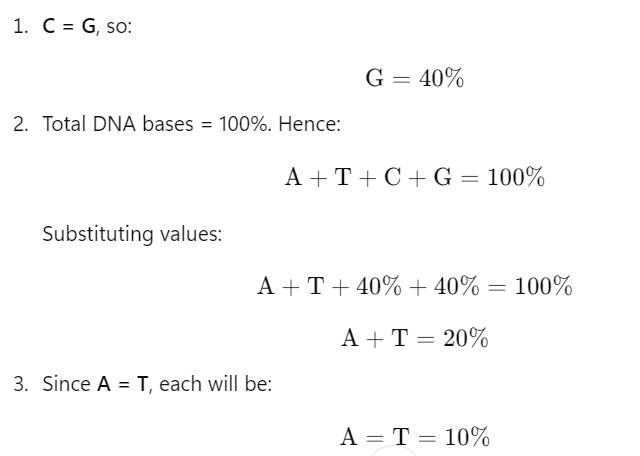
Answer:
- A = 10%, T = 10%, C = 40%, G = 40%.
Practise Questions
Question 1
Define the genetic code and explain its significance in cellular function. (5 marks)
Mark Scheme:
- The genetic code is the sequence of DNA bases that encodes the amino acid sequence in proteins. (1 mark)
- It is composed of codons, which are triplets of bases that specify particular amino acids. (1 mark)
- The genetic code controls cell functions by determining the sequence of amino acids in enzymes and other proteins, which are essential for cellular activities. (1 mark)
- It ensures that proteins are synthesized with the correct amino acid sequence, maintaining their proper shape and function. (1 mark)
- The genetic code is universal, meaning it is used consistently across almost all living organisms, suggesting a common evolutionary origin. (1 mark)
Question 2
Explain the triplet code hypothesis and why three bases are necessary to encode the 20 amino acids. (6 marks)
Mark Scheme:
- The triplet code hypothesis states that each amino acid is specified by a sequence of three DNA bases (a codon). (1 mark)
- There are 4 different bases in DNA (A, T, G, C), so a triplet code allows for 4³ = 64 combinations. (1 mark)
- Two bases (4² = 16 combinations) are insufficient to encode all 20 amino acids. (1 mark)
- A triplet code provides 64 possible codons, which is more than enough to encode the 20 amino acids, allowing for redundancy (degeneracy) in the genetic code. (1 mark)
- Redundancy means that some amino acids are coded by more than one codon, which helps reduce the impact of mutations. (1 mark)
- This structure ensures that the genetic code is flexible and reliable, allowing accurate protein synthesis despite genetic variations. (1 mark)
Question 3
List and describe three key features of the genetic code. (6 marks)
Mark Scheme:
- Triplet Code: Each amino acid is specified by a triplet of bases (codon), allowing for 64 possible combinations. (1 mark)
- Universality: The genetic code is nearly the same across all living organisms, indicating a common evolutionary origin. (1 mark)
- Start and Stop Codons: Specific codons signal the beginning (e.g., AUG for methionine) and end (e.g., UAA, UAG, UGA) of protein synthesis. (1 mark)
- Redundancy (Degeneracy): Multiple codons can code for the same amino acid, reducing the likelihood that mutations will affect protein function. (1 mark)
- Non-Overlapping: Codons are read one after another without overlapping, ensuring each base is part of only one codon. (1 mark)
- No Punctuation: The genetic code is continuous, without any gaps or spaces between codons, allowing for efficient translation. (1 mark)
Question 4
What does the universality of the genetic code suggest about the evolution of life on Earth? (5 marks)
Mark Scheme:
- The universality of the genetic code means that it is consistent across nearly all living organisms. (1 mark)
- This suggests that all life on Earth shares a common evolutionary ancestor. (1 mark)
- The consistency indicates that the genetic code originated early in evolutionary history and has been conserved due to its fundamental role in protein synthesis. (1 mark)
- It implies that the mechanisms of DNA replication and protein synthesis are highly efficient and essential, leading to their preservation. (1 mark)
- The universality also supports the idea of horizontal gene transfer and the interconnectedness of life forms through evolutionary processes. (1 mark)
Question 5
Describe how redundancy in the genetic code can reduce the impact of mutations. (5 marks)
Mark Scheme:
- Redundancy means that multiple codons can code for the same amino acid. (1 mark)
- If a mutation changes the third base of a codon, it may still code for the same amino acid, resulting in a silent mutation. (1 mark)
- This reduces the likelihood that mutations will alter the amino acid sequence of proteins, preserving their function. (1 mark)
- Redundancy provides a buffer against genetic errors, enhancing protein stability and cellular function. (1 mark)
- It helps maintain the integrity of the genetic information, preventing potentially harmful changes in proteins despite genetic variations. (1 mark)
Question 6
What are start and stop codons, and what roles do they play in protein synthesis? (5 marks)
Mark Scheme:
- Start Codon: Typically AUG, which codes for methionine and signals the initiation of protein synthesis. (1 mark)
- Stop Codons: Include UAA, UAG, and UGA, which do not code for any amino acid and signal the termination of protein synthesis. (1 mark)
- Start codons mark the beginning of an open reading frame, where translation into a protein starts. (1 mark)
- Stop codons ensure that the polypeptide chain is synthesized to the correct length by signaling ribosomes to release the newly formed protein. (1 mark)
- They provide punctuation in the genetic code, delineating the start and end points of protein-coding sequences, ensuring accurate and efficient translation. (1 mark)
Question 7
Apply Chargaff’s Rule to calculate the percentage of guanine (G) and cytosine (C) in a double-stranded DNA molecule that contains 25% adenine (A) and 25% thymine (T). (5 marks)
Mark Scheme:
- According to Chargaff’s Rule, A = T and G = C in double-stranded DNA. (1 mark)
- Given A = 25% and T = 25%, the total percentage of A and T is 50%. (1 mark)
- The remaining 50% must be divided equally between G and C. (1 mark)
- Therefore, G = 25% and C = 25%. (1 mark)
- Answer: G = 25%, C = 25%. (1 mark)
Question 8
A double-stranded DNA molecule has 30% adenine (A) and 20% cytosine (C). Calculate the percentages of thymine (T) and guanine (G). (5 marks)
Mark Scheme:
- According to Chargaff’s Rule, A = T and G = C. (1 mark)
- Given A = 30%, then T = 30%. (1 mark)
- Given C = 20%, then G = 20%. (1 mark)
- Check: A + T + C + G = 30% + 30% + 20% + 20% = 100%. (1 mark)
- Answer: T = 30%, G = 20%. (1 mark)
Question 9
Explain why Chargaff’s Rule does not apply to single-stranded DNA or RNA molecules. (4 marks)
Mark Scheme:
- Chargaff’s Rule is based on base pairing in double-stranded DNA, where A pairs with T and G pairs with C. (1 mark)
- In single-stranded DNA or RNA, there is no complementary strand for A to pair with T or G to pair with C. (1 mark)
- Without base pairing, the ratios of A, T, G, and C do not need to be equal, allowing for variable proportions. (1 mark)
- Therefore, Chargaff’s ratios are not maintained in single-stranded nucleic acids. (1 mark)
Question 10
Why is the genetic code considered degenerate, and what advantage does this provide to organisms? (5 marks)
Mark Scheme:
- The genetic code is degenerate because multiple codons can code for the same amino acid. (1 mark)
- For example, leucine is encoded by six different codons (UUA, UUG, CUU, CUC, CUA, CUG). (1 mark)
- This redundancy means that mutations in the third base of a codon often do not change the amino acid, resulting in silent mutations. (1 mark)
- It provides an advantage by reducing the impact of genetic mutations on protein function, enhancing protein stability. (1 mark)
- Degeneracy allows organisms to tolerate genetic variations without detrimental effects, promoting genetic diversity and evolutionary adaptability. (1 mark)
Example Problem 1
If a double-stranded DNA molecule contains 30% adenine (A), calculate the percentages of thymine (T), cytosine (C), and guanine (G). (5 marks)
Mark Scheme:
- According to Chargaff’s Rule, A = T and G = C. (1 mark)
- Given A = 30%, then T = 30%. (1 mark)
- The total percentage of A and T is 60%, so the remaining 40% must be equally divided between C and G. (1 mark)
- Therefore, C = 20% and G = 20%. (1 mark)
- Answer: T = 30%, C = 20%, G = 20%. (1 mark)
Example Problem 2
A double-stranded DNA sample has 40% cytosine (C). Calculate the percentage of adenine (A), thymine (T), and guanine (G). (5 marks)
Mark Scheme:
- According to Chargaff’s Rule, G = C. Given C = 40%, then G = 40%. (1 mark)
- The total percentage of G and C is 80%. (1 mark)
- The remaining 20% must be divided equally between A and T. (1 mark)
- Therefore, A = 10% and T = 10%. (1 mark)
- Answer: A = 10%, T = 10%, G = 40%. (1 mark)
Quizzes
Test 1
Test 2
Test 3